Are you curious about what yuca tastes like? You’re not alone.
As one of the most popular ingredients in Latin American cuisine, it can be a mystery to new eaters.
In this article, you’ll get all the details on yuca’s flavor and how to prepare it.
Get ready for an exciting culinary adventure.
What is Yuca?

Yuca, also known as cassava, is a starchy root vegetable that is a dietary staple in many countries around the world.
It is similar in shape to a sweet potato, but with a rough, dark-brown exterior and a white, fibrous interior.
Yuca is a good source of carbohydrates, dietary fiber, and essential vitamins and minerals.
Yuca can be boiled, fried, or baked, and is used in a variety of dishes, from stews and soups to cakes and bread.
In some cultures, yuca is fermented to produce a traditional alcoholic beverage known as cassava beer.
Despite being a versatile and widely used ingredient, it is important to note that improper preparation of yuca can lead to the formation of cyanide, which can cause serious health problems.
Therefore, it is crucial to follow proper cooking procedures or purchase pre-processed yuca products to ensure safe consumption.
What Does Yuca Taste Like?
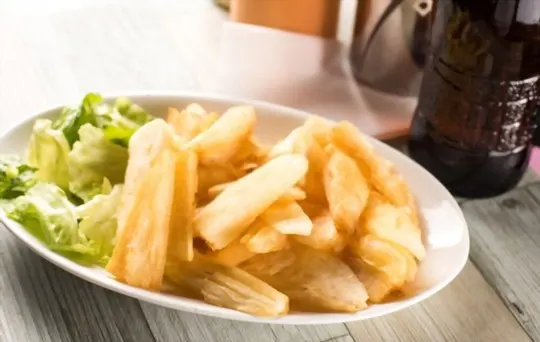
Yuca, also known as cassava, has a unique flavor profile that is slightly sweet and nutty, with a slightly fibrous texture.
Yuca tastes similar to potatoes but has a more earthy, nutty taste.
Additionally, it has a slightly sweet flavor that pairs well with savory dishes.
Yuca is a versatile ingredient used in a variety of dishes, such as stews, soups, casseroles, and even desserts.
Here are some quick facts on yuca:
- Yuca is a starchy root vegetable that grows in tropical climates.
- It is a major source of carbohydrates and other essential nutrients, such as potassium, vitamin C, and folate.
- Yuca can be boiled, fried, mashed, or baked, making it a versatile ingredient in many cuisines around the world.
- Although yuca is gluten-free, it is important to note that some products made from yuca, such as yuca flour or tapioca, may contain gluten if they are processed in facilities that also process gluten-containing products.
Cooking Methods to Enhance the Flavor of Yuca
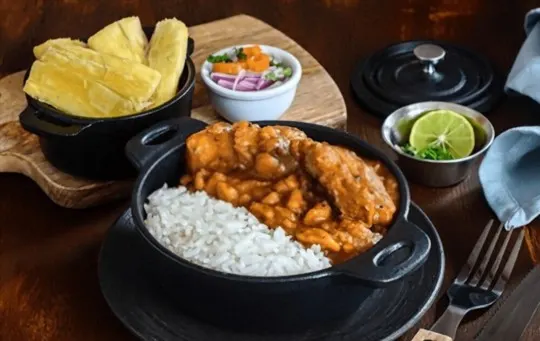
Yuca, also known as cassava, has a mild and nutty flavor that can be enhanced by different cooking methods.
Here are some of the best ways to prepare yuca to bring out its unique taste:
- Boiling: Boiling is the easiest and most popular way to cook yuca. This method involves boiling yuca chunks in salted water until tender. It is essential to remove the fibrous core from the yuca root before boiling.
- Frying: Frying yuca makes it crispy on the outside while still soft on the inside. Preheat oil in a deep fryer or pot, cut the yuca into pieces, and fry them until golden brown.
- Roasting: Roasting yuca enhances its natural sweetness and nutty flavor. Cut the yuca into wedges, toss them with olive oil, and roast them in the oven until golden brown.
- Mashing: Mashing yuca turns it into a puree-like consistency, which can be used as a side dish or a base for other recipes. Boil the yuca until tender, drain any excess water, and mash it with a fork or a potato masher.
Each cooking method is unique and offers different results, so try each to find your favorite.
To add extra flavor, season your yuca with your favorite herbs and spices before cooking.
1 – Boiling
Boiling is one of the most common methods of preparing yuca root, a starchy vegetable with a mild, nutty flavor.
Here is how to boil yuca:
- Peel the yuca root and cut it into chunks or strips.
- Bring a pot of salted water to a boil.
- Add the yuca to the boiling water and reduce the heat to a simmer.
- Cook until the yuca is tender, about 20-30 minutes.
- Drain the yuca and serve it on its own or as a side dish.
Yuca root has been described as having a flavor and texture similar to that of potatoes or sweet potatoes.
It can be boiled, fried, roasted, mashed, or used in stews and soups.
In addition to being a delicious food, yuca root is also a good source of carbohydrates, fiber, and vitamin C.
Pro tip: To enhance the flavor, try adding seasonings or spices to the boiling water, such as garlic, bay leaves, or cumin.
2 – Frying
Frying is one of the most common and delicious ways to eat yuca, a starchy root vegetable with a mild, slightly sweet flavor and a dense texture.
Here’s a step-by-step guide on how to fry yuca:
- Peel and cut the yuca root into sticks or chunks.
- Boil the cut yuca in salted water for 15-20 minutes, until fork-tender.
- Remove the yuca from the water and let it cool for a few minutes.
- Heat a frying pan or deep fryer with oil over medium-high heat.
- Fry the yuca in the hot oil until it turns crispy and golden brown.
- Remove the yuca from the oil and let it cool on a paper towel to absorb excess oil.
Yuca has a mild flavor and absorbs the flavors of the spices and seasonings used in the frying process.
It tastes best when fried to crispy perfection and served with a dipping sauce, such as garlic aioli or spicy mayo.
To add an extra layer of flavor to your fried yuca, try seasoning it with spices like cumin, chili powder, or paprika.
3 – Roasting
Roasting is a perfect way to bring out the nutty flavor in yuca, a starchy root vegetable widely consumed in Latin America, Asia, and Africa.
Here’s how to roast your yuca:
- Preheat your oven to 400°F.
- Peel the yuca with a sharp knife and cut it into wedges or cubes.
- Bring a pot of salted water to boil and cook the yuca for 10-15 minutes, or until slightly tender.
- Drain the water and pat the yuca dry with a paper towel.
- Toss the yuca with a drizzle of olive oil or melted butter and sprinkle with salt, pepper, and seasonings of your choice (garlic, cumin, paprika, etc.).
- Place the yuca on a baking sheet in a single layer and bake for 20-25 minutes, flipping halfway through.
When properly roasted, yuca should have a crispy exterior and a soft and creamy interior, with a mildly sweet and nutty taste.
Yuca can be served as a side dish, a snack or a base for various recipes.
Pro Tip: For added flavor, serve the roasted yuca with mojo sauce, a traditional Cuban condiment made with garlic, lime juice, and olive oil.
Nutritional Value of Yuca
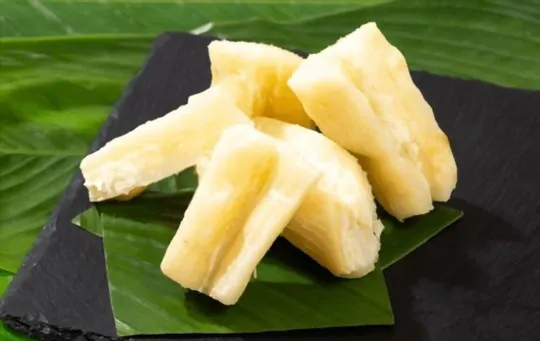
Yuca, also known as cassava, is a starchy root vegetable that is a good source of carbohydrates, fiber, and essential nutrients.
Here is the nutritional breakdown of 1 cup (206g) of raw yuca:
- Calories: 330.
- Carbohydrates: 78g.
- Fiber: 4g.
- Protein: 3g.
- Fat: 0.4g.
- Vitamin C: 47% of the Daily Value (DV).
- Thiamine: 22% of the DV.
- Folate: 19% of the DV.
- Calcium: 3% of the DV.
- Iron: 12% of the DV.
Yuca has a mild, slightly sweet flavor that is similar to a potato, but with a firmer and starchier texture.
Its taste can vary depending on how it’s cooked and what it’s paired with.
When buying yuca, choose roots that are firm, with smooth, unblemished skin.
Store them in a cool, dry place for up to a week or in the refrigerator for up to two weeks.
To prepare yuca, peel off the tough outer layer, cut it into pieces, and boil or bake it until it’s soft.
How to Buy and Store Yuca?
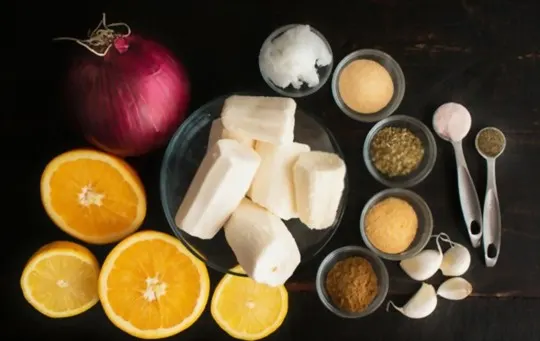
Yuca, also known as cassava, is a starchy root vegetable that is widely used in Latin American, Caribbean, and African cuisine.
Its taste and texture are often compared to those of potatoes, but with a slightly sweeter and nuttier flavor.
To buy and store yuca, follow these steps:
- Look for firm, unblemished yuca roots that are free of cracks and soft spots.
- Avoid yuca roots that have a grayish tinge, as this indicates that they are past their prime.
- Once you have bought yuca, store it in a cool, dry place for up to two weeks.
- Do not wash yuca before storing it, as this can accelerate spoilage.
When it comes to preparing yuca, there is an important first step to keep in mind: yuca contains a toxic compound that must be removed.
Here is how to prepare yuca for cooking:
- Cut both ends off the yuca root and slice it lengthwise down the middle.
- Use a paring knife to remove the waxy, outer layer.
- Rinse the yuca under cool water and cut it into smaller pieces.
- Place the yuca in a pot and cover it with cold water.
- Bring the water to a boil and let the yuca cook for 15-20 minutes, or until it is tender.
- Drain the water and serve the yuca as desired.
Yuca can be boiled, fried, baked, or mashed, and makes a great substitute for potatoes or other starchy vegetables in a variety of dishes.
Conclusion
In conclusion, yuca has a unique taste that is both earthy and nutty, with a slightly sweet flavor.
This starchy root vegetable is rich in nutrients such as dietary fiber, vitamin C, and potassium, and can be prepared in a variety of ways, including boiling, frying, and baking.
Yuca is a versatile ingredient that is widely used in Latin American, African, and Caribbean cuisines, and is gaining popularity in other parts of the world due to its delicious taste and health benefits.
Whether you are trying yuca for the first time or experimenting with a new recipe, this root vegetable is sure to add flavor and nutrition to your meals.
So, go ahead and give yuca a try in your next culinary adventure.
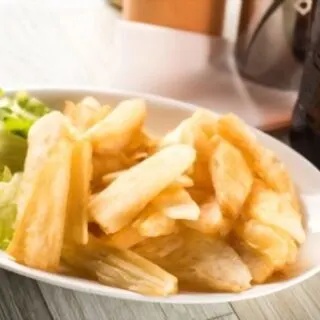
What Does Yuca Taste Like? A Comprehensive Guide
Ingredients
- Yuca
- Ingredients from your selected recipes
Instructions
- Select your favorite ingredient from the range available in this article.
- Collect all the necessary items to make the recipe.
- Use the instructions provided to prepare a delicious dish in 30 minutes or less.

Carrie is a food writer and editor with more than 15 years of experience. She has worked for some of the biggest names in the food industry, including Bon Appétit, Food & Wine, and Martha Stewart Living.
As the Editor in Chief of IntroChicago.com, Carrie oversees all of the content on the site. She also manages the team of contributing writers and editors, who help to create delicious recipes, helpful tips, and informative articles that you’ll find on the site.
A native of the Chicago area, Carrie is passionate about all things food. She loves trying new restaurants and experimenting with new recipes in her kitchen. She’s also a graduate of the Culinary Institute of America, so she knows a thing or two about food!
